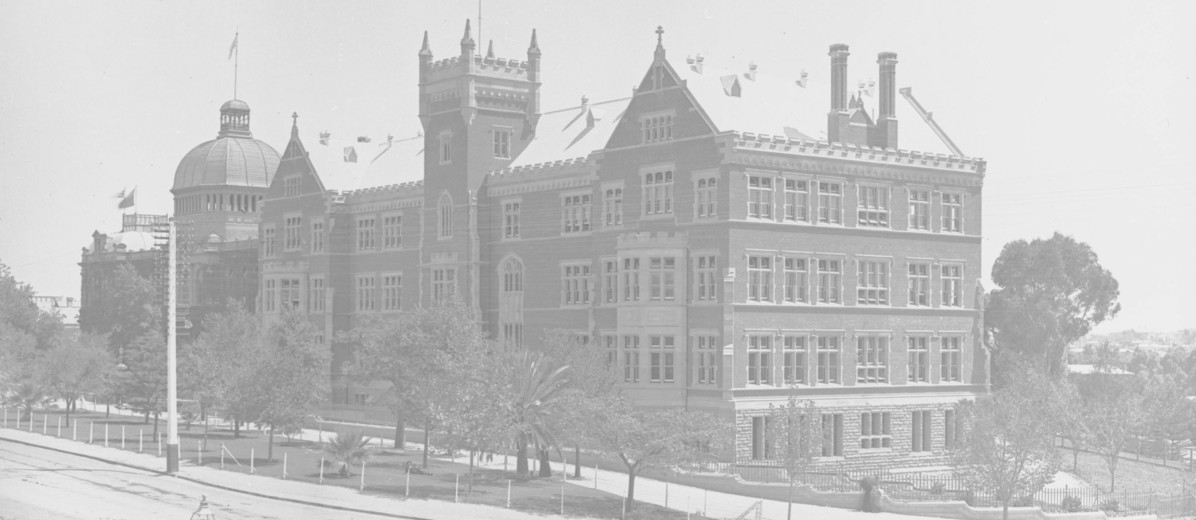Person
ContributeRobert William Chapman was born at Stony Stratford, Buckinghamshire, England, on 27th December 1866, the son of currier Charles Chapman and his wife Matilda (née Harrison). In 1876 he emigrated with his family to Melbourne, where he attended Wesley College and Melbourne University. After completing a B.A. in 1886 and a B.C.E. and M.A. in 1888, he was appointed Assistant Lecturer in mathematics and physics at the University of Adelaide in 1889. The following year he also began teaching mathematics at the South Australian School of Mines and Industries.
On 14th February 1889 he married Eva Maud Hall with whom he had six sons and two daughters. After lecturing in engineering for several years, he became the first Professor of Engineering at the University in 1907. From 1910 to 1919 he replaced William Bragg as Professor of Mathematics and Mechanics before being reappointed in 1920 as Professor of Engineering, holding this position until his retirement in 1937.
Chapman believed strongly that engineering should be given professional status. Earlier training of engineers had been done through informal ‘pupilage’, i.e. apprentice-ships, but Chapman argued for joint courses by the University and the School of Mines and Industries. These were introduced in 1903 and eventually degree courses in several branches of engineering were established at the University, in particular, the course in civil engineering, initially considered unwarranted as being ‘simply the opposite of military engineering’.
He continued to promote professionalism, as a founding member and President of the S.A. Institute of Engineers, established in 1913, and as President of the Institution of Engineers Australia. Chapman taught many pupils who later distinguished themselves, including Essington Lewis, H.T.M. Angwin (Chief Engineer of the S.A. Harbours Board), and his own son, Robert Hall Chapman (Chief Engineer of the S.A. Railways).
Although his teaching load was diverse and heavy, he carried out original research into the structures of metals, timber and concrete, and also studied tidal behaviour and astronomy. He was made a Fellow of the Royal Astronomical Society in 1909 and actively supported the Astronomical Society of South Australia, of which he was President for a record 32 years. In 1928 he was awarded the Peter Nicol Russell Medal by the Institution of Engineers and in 1931 the Kernot Memorial Medal by the University of Melbourne.
Many bodies benefited from his expertise: the South Australian government, for whom he worked as a consultant on a wide range of projects including bridges, roads, jetties, railways and breakwaters, the Australian Commonwealth Engineering Standards Association, the Council of the University of Adelaide, where he acted occasionally as Vice-Chancellor, and the South Australian School of Mines and Industries, of which he was President from 1939 to 1942. He was also President of the South Australian Institute of Surveyors from 1917 to 1929. He wrote many papers on engineering as well as two books, The Elements of Astronomy for Surveyors (1918) and Reinforced Concrete (1921).
It was said of him that ‘he had a faculty, amounting almost to genius, of being able to recognize the fundamental essentials in almost any problem’. This, along with the great gift of humility, made him an excellent teacher and endeared him to his students.
Chapman was appointed C.M.G. in 1927, was made Emeritus Professor on his retirement in 1937 and was knighted in 1938. He died on 24th February 1942 and was buried at North Road Cemetery. He is commemorated by the Institution of Engineers’ R.W. Chapman Medal, and a portrait of him by Ivor Hele hangs in the Chapman Theatre of the engineering school at the University of Adelaide.
Media
Add mediaImages

Courtsy State Library of South Australia, SLSA B 19205

Courtesy State Library of South Australia, SLSA B 6083. Public domain



CommentAdd new comment
Quickly, it's still quiet here; be the first to have your say!